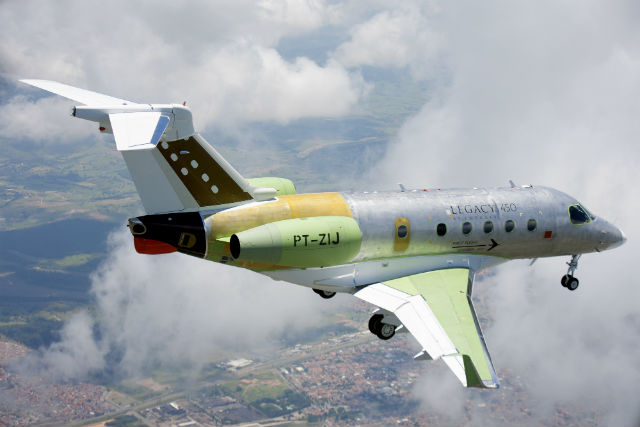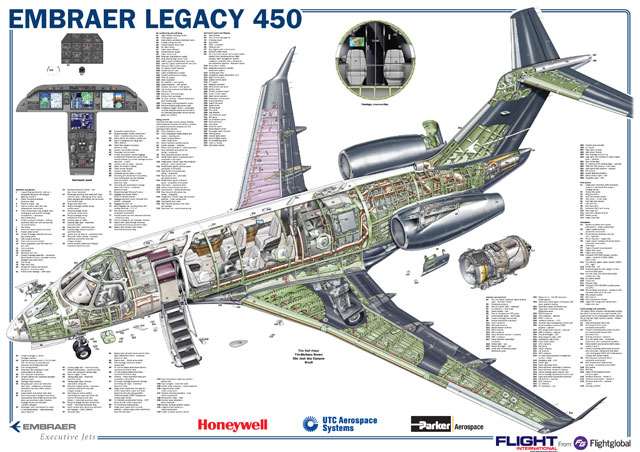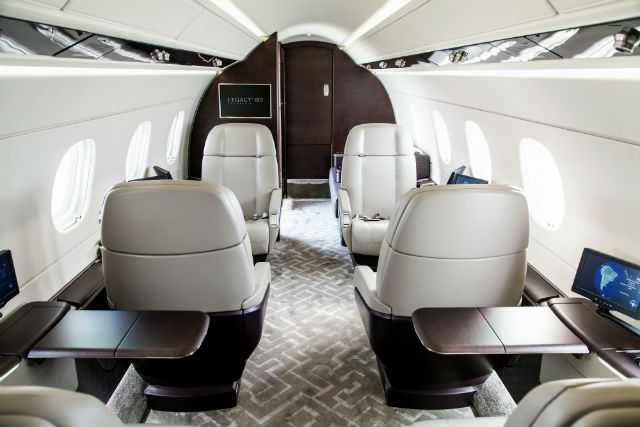Delivering the first Legacy 450 later this year marks the passage of a remarkable milestone. It means Embraer Executive Jets will not have a new aircraft in development for the first time since 2005, completing an industry-altering decade of product activity. Having laid a seven-aircraft foundation, starting with the Legacy 600 15 years ago, Embraer now plans to build on it.
Before Embraer entered the market, Hawker-branded business jets were still in production. Passenger cabins with flat floors and 1.82m ceilings were luxuries reserved for market segments above the midsize class. Fly-by-wire technology was available – at a price point above $50 million.
Then came the Brazilian intervention. Established in 1969 by the Brazilian air force, Embraer had been privatised by 1994 and cemented its future in the regional jet market with the arrival of the E-Jet family in 2004. By then, the company’s 4,000 engineers and 2,000 technicians needed a new project. The light and mid-size segments of the business jet market have always attracted entrepreneurs and start-ups promising new technology, but few of these attempts have had the financial backing and engineering clout of Embraer.
So Embraer launched the Phenom 100 and 300 entry-level and light business jets, respectively, in 2005. Two commercial derivatives – the Legacy 650 and Lineage 1000 – followed into production. Then Embraer launched the MSJ and MLJ – midsize and mid-light jets, respectively – in 2008, which became the Legacy 500 and Legacy 450.
Fittingly, the Legacy 450 completes the Embraer Executive Jets portfolio as perhaps the most technologically ambitious of the ensemble. It shares with the larger Legacy 500 the same fly-by-wire control system that electronically activates all of the control surfaces, including two ailerons, two elevators, a rudder and six spoiler panels. But Embraer almost seems to downplay its significance on the Legacy 450 by describing the fly-by-wire system as “unique” in its class.

Flight test vehicle
Embraer
Apart from a military jet fighter, the Legacy 450 represents the smallest aircraft yet to appear with a fly-by-wire system and a commercial airworthiness certificate. The same technology can be found in other business jets, but only for a much steeper price. When the much larger and longer-range Gulfstream G500 enters service in 2018, it will come with a $42 million price tag. Embraer sells the Legacy 450 for a little over $16 million.
To the aircraft buyer, the benefits of fly-by-wire technology are not always tangible. It is the bump in the air the passenger doesn’t feel or the unsafe speed the control surfaces prevent the pilot from commanding. But there are still moments that the digital processing of pilot commands come to life for even the most aerodynamically oblivious passenger. The landing gear lowers, but there is no sudden change in speed or attitude as the fly-by-wire system automatically compensates for the aerodynamic disturbance, for example.
COCKPIT
In the cockpit, however, the pilots are immersed in the fly-by-wire experience, starting with the mechanism used for controlling the aircraft in pitch and roll. Embraer’s classic ram horn yokes are replaced by sidestick controllers. With this interface the pilot commands the ailerons and elevators indirectly. By physically manipulating the controller, pilots inform the primary flight control computer of their intentions. Software in the computer translates those inputs into digital messages, which are dispatched to remote electronic units located closer to the control surfaces. These devices send specific instructions to the actuators that move the control surfaces.
By inserting a computer between the pilot and the mechanical systems that activate the motion of ailerons, elevators and rudder, the fly-by-wire system enables new ways of interfacing with the controls, including some that could even seem spooky in a manually-driven flight control system. For instance, the Legacy 450 pilot can push the sidestick forward to command the nose to pitch down. If he simply lets go of the controller, the nose will continue pointing down. The fly-by-wire system will “hold” the pilot’s command until a new input is sent to the flight control computer.
It is possible to design such a feature because the fly-by-wire system won’t allow the aircraft to point down for so long that the aircraft accelerates beyond a structurally-imposed speed limit.
These flight envelope protections are within the discretion of the designer. Boeing has designed fly-by-wire systems that leave final authority with the pilot. The Airbus philosophy invests ultimate authority in the computer. There are commands the computer will simply not allow the pilot to perform. The Embraer philosophy effectively splits the difference.
It defines a “normal” flight envelope measured by speed and attitude. The pilot can make any input within the normal flight envelope, and the flight control computer will allow it. If the pilot must go beyond the normal envelope, the computer is programmed to allow the command, but only if the pilot continues sending the same input. The moment the pilot releases the sidestick, the computer will return the aircraft back to the normal flying envelope.
The digital controls of the fly-by-wire system are complemented by Embraer’s selection of a cockpit system. Embraer has proven especially open-minded when it comes to avionics vendors. Honeywell supplies a version of the Primus Epic integrated avionics system for the E-Jet family cockpits. Garmin is the integrated avionics supplier for the Phenom series aircraft. But the Rockwell Collins Pro Line Fusion won the competition for the cockpit of the Legacy 450.
It features four 15.1in displays in a T layout unimpeded by unnecessary ram horn yokes. A terrain database loaded into the cockpit systems allows pilots to see a synthetic image of the world outside the aircraft at night and in any weather.

Cockpit
Embraer
Like differing philosophies on fly-by-wire controls, avionics companies are also divided on where pilots should look to read instruments. Honeywell prefers a head-down approach for instrument flying, so its cockpit systems display instrument data below the glare shield. Rockwell Collins, by contrast, prefers to keep the pilot looking through the windscreen, so it has developed a line of “head-up” guidance systems.
Aircraft in the size class of the Legacy 450 are especially sensitive to the centre of gravity effects of heavy equipment placed close to the tail or rear of an aircraft. Normal projection equipment, as mounted in the ceiling of the cockpit for head-up systems on much larger aircraft, is too heavy for the Legacy 450. But Rockwell Collins has developed the HGS-3500 compact HUD for midsize and light business jets.
The compact HUD displays normal guidance on speed, altitude and heading from the flight computer. An upgrade now in flight test will also allow the pilots to use the HUD to “see” through darkness and bad weather. External sensors will feed a composite image of the outside world into the HUD. That image is overlaid onto the graphical display of the terrain database. As regulators become more comfortable with the technology, manufacturers hope such enhanced vision/synthetic vision (EVS/SVS) systems will allow aircraft to fly and land in any kind of weather. Embraer expects to have the EVS capability certificated on the compact HUD as an optional upgrade for customers next year.

Click here to enlarge and purchase this cutaway
NAVIGATION
Embraer also introduced new technology in the navigation system. The most accurate inertial navigation systems using laser-ring gyros are heavy, expensive and need ram air ports for cooling. But Embraer is introducing the Northrop Grumman LITEF APS 4000, a lightweight attitude heading and reference system (AHRS) based on a fibre-optic gyro. It is slightly less accurate than a laser-ring gyro with a drift rate of 12nm/h. The result is a state-of-the-art AHRS in the Legacy 450, but at a fraction of the price of an internal system.
With two Honeywell HTF7500E turbofan engines, long-range cruise speed for the Legacy 450 is Mach 0.76. Although speed is partly a function of thrust, it is also enabled by the shape of the wing. But herein lies one of the great trade-offs of aerodynamic design. An easy way to make an aircraft go faster is to add thrust and reduce the size of the wing, thereby reducing drag. But another key performance requirement is minimizing take-off and landing distance, allowing the aircraft access to more airports. And that requires as much wing area as can be spared.
As with most aerodynamic applications, solution involves compromise. The inboard section of the Legacy 450 wing is swept back sharply at 27˚, accommodating the aerodynamicist’s pursuit of as much speed as possible. At roughly one-third span, however, the sweep angle is tapered back in the service of take-off and landing performance.
Inside the wing of the Legacy 450 lies a key difference with its larger sister, the Legacy 500. Embraer designed the mid-sized Legacy 500 to provide a 3,000nm range. Flight testing demonstrated the aircraft is capable of flying a little further – 3,150nm. That’s enough to fly from Sao Paulo, Brazil to Miami. The Legacy 450 is built to fly just as far; it shares the wing area and potential fuel volume of the Legacy 500. But as a super-light class jet, Embraer artificially limited the fuel capacity of the Legacy 450 to accommodate a range of 2,575nm. That’s enough to fly from Sao Paulo to the northern tip of South America, but stops short of crossing the Caribbean Sea.
Inspecting the cabin exterior reveals an obvious difference between the two aircraft. The Legacy 500 sports eight cabin windows versus six for the Legacy 450. Although seemingly trivial, window placement actually drove a structural redesign in the centre fuselage of the Legacy 450. To precisely match the seats with the window positions, Embraer adjusted the space between the structural frames upon which the fuselage skins are attached laterally. The aft and nose sections of the fuselage of the Legacy 450 are nearly identical copies of the Legacy 500.
INTERIOR
Only a decade ago, it was rare to find an aircraft in this size class with a range greater than 2,000nm. As the Legacy 450 and rivals, such as the Cessna Citation Latitude, raise the standard in the category to a minimum of 2,500nm and flights of up to 6h endurance, the emphasis on getting the interior environment right becomes more important.
According to some accounts, Embraer is quietly responsible for revolutionising how business aircraft manufacturers approach interior design. The company’s decision to hire BMW Designworks to sculpt the interior concept for the Phenom was a proverbial shot across the bow. If new competitors would re-imagine the business jet interior with concepts from the automotive sector, the in-house cabinetry departments that have dominated cabin lay-outs for decades would no longer cut it.

Legacy 450 Interior
Embraer

BMW concept interior
BMW Designworks
In the beginning, BMW Designworks also was brought in to propose an interior for the Legacy 450 and 500. The Jetsons-like result immediately gained attention, winning awards and recognition. But some features, such as bright, cabin-length lighting valences and oddly-shaped working tables, raised as many eyebrows as appreciative sighs.
In the end, Embraer decided to take the interior design of the Legacy 500 and 450 back in-house. But by then the company had the services of a new engineering centre in Melbourne, Florida, which is dedicated to supporting interior cabin designs for business jets and premium cabins for airliners.

Legacy 450
Embraer
Source: FlightGlobal.com
















